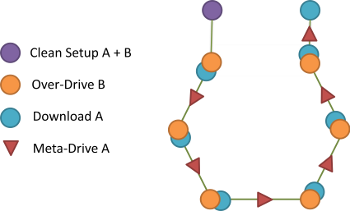Table of Contents
The Basic Formula
Introduction
The basic processes of emergent knowledge can be used in isolation when required in therapy/coaching, or they can be grouped together into specific algorithms to be run as integrated therapeutic processes.
Probably the simplest of these formulas is the ‘Clean Network’ or ‘Basic Formula’.
Starting The Formula
Invite the client to create their ‘Mission Statement’, place it in space where it belongs and then place themselves in relation to it.
Applying The Formula
- Run a Clean Start
- Over-Drive A (with Upload)
- Download A
- Meta-Drive A
- Run parts 2, 3 and 4 five more times
- Download A
A full transcript of this process is provided.
The Basic Formula in visual form:
Figure 26
This particular formula over-drives, downloads and meta-drives ‘A’. The same formula can be applied to ‘B’, although not within the same iteration. We recommend keeping each iteration as simple as possible, enabling the client to add their own complexity.
We are also limiting ourselves to the Power of Six algorithm with regards to the spaces that the client is working from, i.e. the client is moved through six spaces with six iterations (36 pieces of knowledge) + 6 Downloads within the main section = 42 pieces of knowledge. Douglas Adams would be proud!
The clients language in each space will reflect in a fractal/holographic nature the Power of Six stages, this is a wonder to observe and is also a rock to hold onto, for when the client is in the 4th or 5th stage and is beginning to really ‘heat up’; as a therapist we may of attempted to shift them out of the problem, but as an Emergent Knowledge facilitator we are keeping them on the boil! Know that as they continue to move on, their liberation awaits them in their 6th step.
For the visual and kinaesthetic learners the ‘Basic Formula’ can also be shown spatially (from an elevated position/plan view), here ‘B’ is the focus of the over-driving:
Figure 27
Contrast and Compare
At the end of the process it can be useful to have the client take a meta-meta-position to the whole problem, by asking:
- “And knowing what you know now, what do you notice about the difference between your initial statement and your last statement?”
- “And knowing that what difference does that make?”
The Closure
To bring a gentle closure to the session:
- “And is there anything else you'd like to share before we finish?”
- “Ok, this is the end.”

